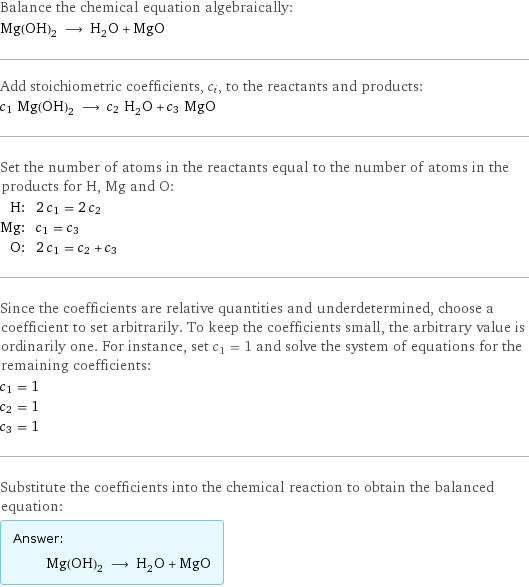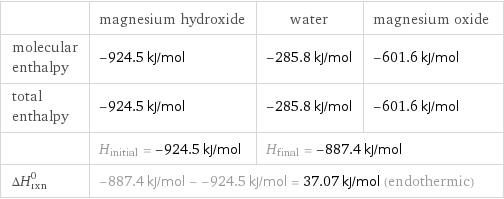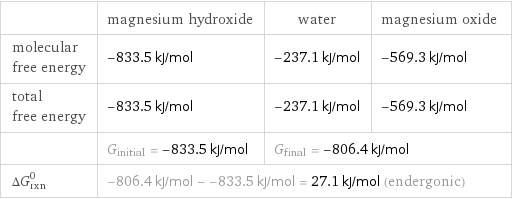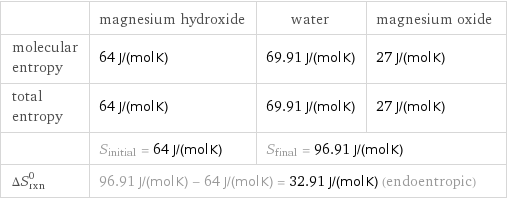Input interpretation

Mg(OH)_2 magnesium hydroxide ⟶ H_2O water + MgO magnesium oxide
Balanced equation

Balance the chemical equation algebraically: Mg(OH)_2 ⟶ H_2O + MgO Add stoichiometric coefficients, c_i, to the reactants and products: c_1 Mg(OH)_2 ⟶ c_2 H_2O + c_3 MgO Set the number of atoms in the reactants equal to the number of atoms in the products for H, Mg and O: H: | 2 c_1 = 2 c_2 Mg: | c_1 = c_3 O: | 2 c_1 = c_2 + c_3 Since the coefficients are relative quantities and underdetermined, choose a coefficient to set arbitrarily. To keep the coefficients small, the arbitrary value is ordinarily one. For instance, set c_1 = 1 and solve the system of equations for the remaining coefficients: c_1 = 1 c_2 = 1 c_3 = 1 Substitute the coefficients into the chemical reaction to obtain the balanced equation: Answer: | | Mg(OH)_2 ⟶ H_2O + MgO
Structures

⟶ +
Names

magnesium hydroxide ⟶ water + magnesium oxide
Reaction thermodynamics
Enthalpy

| magnesium hydroxide | water | magnesium oxide molecular enthalpy | -924.5 kJ/mol | -285.8 kJ/mol | -601.6 kJ/mol total enthalpy | -924.5 kJ/mol | -285.8 kJ/mol | -601.6 kJ/mol | H_initial = -924.5 kJ/mol | H_final = -887.4 kJ/mol | ΔH_rxn^0 | -887.4 kJ/mol - -924.5 kJ/mol = 37.07 kJ/mol (endothermic) | |
Gibbs free energy

| magnesium hydroxide | water | magnesium oxide molecular free energy | -833.5 kJ/mol | -237.1 kJ/mol | -569.3 kJ/mol total free energy | -833.5 kJ/mol | -237.1 kJ/mol | -569.3 kJ/mol | G_initial = -833.5 kJ/mol | G_final = -806.4 kJ/mol | ΔG_rxn^0 | -806.4 kJ/mol - -833.5 kJ/mol = 27.1 kJ/mol (endergonic) | |
Entropy

| magnesium hydroxide | water | magnesium oxide molecular entropy | 64 J/(mol K) | 69.91 J/(mol K) | 27 J/(mol K) total entropy | 64 J/(mol K) | 69.91 J/(mol K) | 27 J/(mol K) | S_initial = 64 J/(mol K) | S_final = 96.91 J/(mol K) | ΔS_rxn^0 | 96.91 J/(mol K) - 64 J/(mol K) = 32.91 J/(mol K) (endoentropic) | |
Equilibrium constant
![Construct the equilibrium constant, K, expression for: Mg(OH)_2 ⟶ H_2O + MgO Plan: • Balance the chemical equation. • Determine the stoichiometric numbers. • Assemble the activity expression for each chemical species. • Use the activity expressions to build the equilibrium constant expression. Write the balanced chemical equation: Mg(OH)_2 ⟶ H_2O + MgO Assign stoichiometric numbers, ν_i, using the stoichiometric coefficients, c_i, from the balanced chemical equation in the following manner: ν_i = -c_i for reactants and ν_i = c_i for products: chemical species | c_i | ν_i Mg(OH)_2 | 1 | -1 H_2O | 1 | 1 MgO | 1 | 1 Assemble the activity expressions accounting for the state of matter and ν_i: chemical species | c_i | ν_i | activity expression Mg(OH)_2 | 1 | -1 | ([Mg(OH)2])^(-1) H_2O | 1 | 1 | [H2O] MgO | 1 | 1 | [MgO] The equilibrium constant symbol in the concentration basis is: K_c Mulitply the activity expressions to arrive at the K_c expression: Answer: | | K_c = ([Mg(OH)2])^(-1) [H2O] [MgO] = ([H2O] [MgO])/([Mg(OH)2])](../image_source/73d20b79dbba1e737a32fec6f12bbe7a.png)
Construct the equilibrium constant, K, expression for: Mg(OH)_2 ⟶ H_2O + MgO Plan: • Balance the chemical equation. • Determine the stoichiometric numbers. • Assemble the activity expression for each chemical species. • Use the activity expressions to build the equilibrium constant expression. Write the balanced chemical equation: Mg(OH)_2 ⟶ H_2O + MgO Assign stoichiometric numbers, ν_i, using the stoichiometric coefficients, c_i, from the balanced chemical equation in the following manner: ν_i = -c_i for reactants and ν_i = c_i for products: chemical species | c_i | ν_i Mg(OH)_2 | 1 | -1 H_2O | 1 | 1 MgO | 1 | 1 Assemble the activity expressions accounting for the state of matter and ν_i: chemical species | c_i | ν_i | activity expression Mg(OH)_2 | 1 | -1 | ([Mg(OH)2])^(-1) H_2O | 1 | 1 | [H2O] MgO | 1 | 1 | [MgO] The equilibrium constant symbol in the concentration basis is: K_c Mulitply the activity expressions to arrive at the K_c expression: Answer: | | K_c = ([Mg(OH)2])^(-1) [H2O] [MgO] = ([H2O] [MgO])/([Mg(OH)2])
Rate of reaction
![Construct the rate of reaction expression for: Mg(OH)_2 ⟶ H_2O + MgO Plan: • Balance the chemical equation. • Determine the stoichiometric numbers. • Assemble the rate term for each chemical species. • Write the rate of reaction expression. Write the balanced chemical equation: Mg(OH)_2 ⟶ H_2O + MgO Assign stoichiometric numbers, ν_i, using the stoichiometric coefficients, c_i, from the balanced chemical equation in the following manner: ν_i = -c_i for reactants and ν_i = c_i for products: chemical species | c_i | ν_i Mg(OH)_2 | 1 | -1 H_2O | 1 | 1 MgO | 1 | 1 The rate term for each chemical species, B_i, is 1/ν_i(Δ[B_i])/(Δt) where [B_i] is the amount concentration and t is time: chemical species | c_i | ν_i | rate term Mg(OH)_2 | 1 | -1 | -(Δ[Mg(OH)2])/(Δt) H_2O | 1 | 1 | (Δ[H2O])/(Δt) MgO | 1 | 1 | (Δ[MgO])/(Δt) (for infinitesimal rate of change, replace Δ with d) Set the rate terms equal to each other to arrive at the rate expression: Answer: | | rate = -(Δ[Mg(OH)2])/(Δt) = (Δ[H2O])/(Δt) = (Δ[MgO])/(Δt) (assuming constant volume and no accumulation of intermediates or side products)](../image_source/c2977a6a6e5173c695e70d4e312a6e98.png)
Construct the rate of reaction expression for: Mg(OH)_2 ⟶ H_2O + MgO Plan: • Balance the chemical equation. • Determine the stoichiometric numbers. • Assemble the rate term for each chemical species. • Write the rate of reaction expression. Write the balanced chemical equation: Mg(OH)_2 ⟶ H_2O + MgO Assign stoichiometric numbers, ν_i, using the stoichiometric coefficients, c_i, from the balanced chemical equation in the following manner: ν_i = -c_i for reactants and ν_i = c_i for products: chemical species | c_i | ν_i Mg(OH)_2 | 1 | -1 H_2O | 1 | 1 MgO | 1 | 1 The rate term for each chemical species, B_i, is 1/ν_i(Δ[B_i])/(Δt) where [B_i] is the amount concentration and t is time: chemical species | c_i | ν_i | rate term Mg(OH)_2 | 1 | -1 | -(Δ[Mg(OH)2])/(Δt) H_2O | 1 | 1 | (Δ[H2O])/(Δt) MgO | 1 | 1 | (Δ[MgO])/(Δt) (for infinitesimal rate of change, replace Δ with d) Set the rate terms equal to each other to arrive at the rate expression: Answer: | | rate = -(Δ[Mg(OH)2])/(Δt) = (Δ[H2O])/(Δt) = (Δ[MgO])/(Δt) (assuming constant volume and no accumulation of intermediates or side products)
Chemical names and formulas

| magnesium hydroxide | water | magnesium oxide formula | Mg(OH)_2 | H_2O | MgO Hill formula | H_2MgO_2 | H_2O | MgO name | magnesium hydroxide | water | magnesium oxide IUPAC name | magnesium dihydroxide | water | oxomagnesium